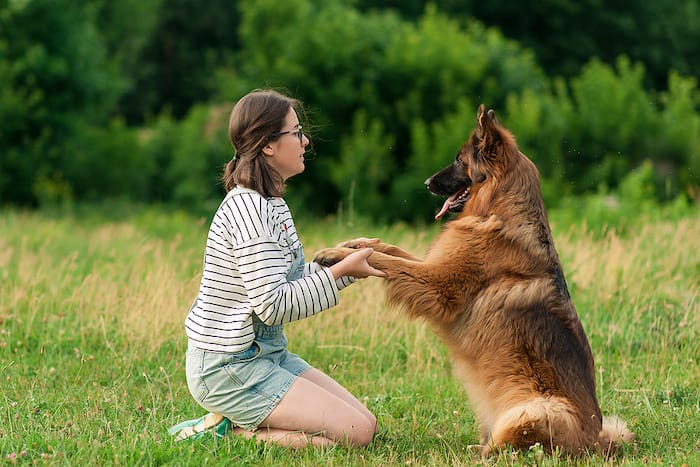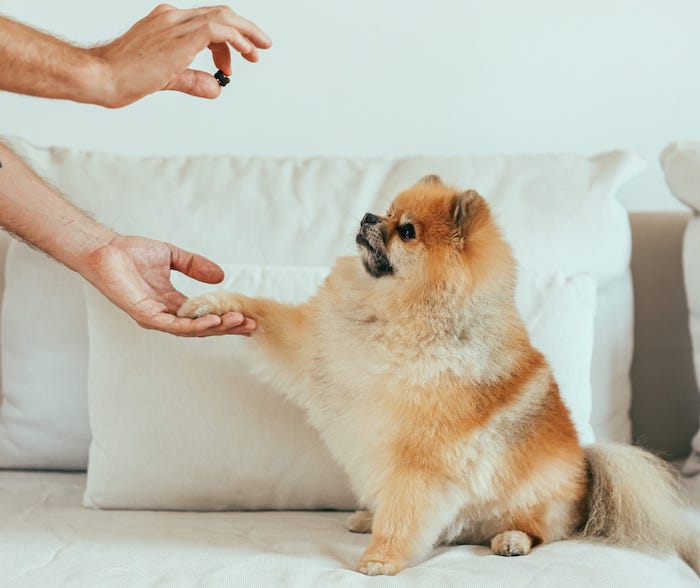In this article, we will delve into the world of positive reinforcement dog training, exploring its benefits, techniques, and commonly asked questions. Positive reinforcement training is a humane and effective approach to teaching dogs desired behaviors by rewarding them for their good actions. By using positive reinforcement methods, we can build a strong bond with our furry friends while fostering their obedience and happiness. So, let’s embark on this journey of understanding how positive reinforcement can transform the way we train and interact with our dogs. Now having said this we also recommend you search for a trainer using this search, dog board and train near me, to find a selection of dog training companies to talk to before you make any decisions.

The Power of Positive Reinforcement
Positive reinforcement is a training method that focuses on rewarding desirable behaviors to encourage their repetition. It relies on the principle that dogs are more likely to learn and repeat behaviors that result in pleasant consequences. By rewarding our canine companions for their good actions, we create a positive association and motivate them to engage in desired behaviors willingly.
Benefits of Positive Reinforcement Training
Positive reinforcement training offers numerous benefits for both dogs and their owners. Let’s explore some of these advantages:
- Promotes a Strong Bond: Positive reinforcement techniques build trust and strengthen the bond between dogs and their owners. When dogs associate their good behavior with rewards and praise, they feel loved and respected, leading to a deeper connection.
- Enhances Communication: Through positive reinforcement training, we establish clear communication channels with our dogs. By rewarding specific behaviors, we provide them with clear feedback on what we expect from them, making training sessions more effective.
- Encourages Good Behavior: Positive reinforcement encourages dogs to display desirable behaviors. By rewarding actions such as sitting, staying, and coming when called, we reinforce their understanding of what is expected, increasing the likelihood of continued good behavior.
- Reduces Behavioral Problems: Positive reinforcement training focuses on rewarding desired behaviors rather than punishing unwanted ones. This approach helps prevent and address behavioral issues such as aggression or excessive barking, as dogs learn alternative behaviors that earn positive reinforcement.
- Increases Confidence: Dogs trained with positive reinforcement methods gain confidence and self-assurance. The positive feedback they receive during training boosts their self-esteem, resulting in a happier and well-adjusted pet.

Essential Techniques for Positive Reinforcement Training
To effectively train your dog using positive reinforcement, it’s essential to understand and apply some proven techniques. These techniques provide a foundation for successful training sessions and help shape your dog’s behavior positively. Continue your dog walking routine and if you don’t have time hire a professional dog walker. Let’s explore these techniques in detail:
- Clicker Training
Clicker training is a popular positive reinforcement technique that uses a distinct sound, typically a handheld clicker, to mark the desired behavior. The sound of the clicker serves as a signal to the dog that they have performed the correct action, followed by an immediate reward. This technique helps in timing the reward accurately and enables precise communication during training.
- Luring
Luring involves using a treat or a target to guide the dog into performing a desired behavior. By placing the treat in front of their nose and moving it in a specific direction, you can entice the dog to follow and execute the desired action. Luring is a helpful technique for teaching commands like “sit” or “down” and can gradually be faded out as the dog becomes more familiar with the behavior.
- Capturing
Capturing involves observing and rewarding a behavior that the dog naturally exhibits. For instance, if your dog sits without any prompting, you can immediately reward them with praise or a treat. This technique capitalizes on the dog’s natural instincts and allows you to reinforce behaviors without actively teaching them.
- Shaping
Shaping involves breaking down complex behaviors into smaller, manageable steps and rewarding the dog for each incremental progress. By rewarding the dog for getting closer to the desired behavior, you gradually shape their actions until they fully accomplish the desired behavior. This technique requires patience and consistency but can be highly effective in training intricate behaviors.
- Chaining
Chaining is a technique that involves linking a series of behaviors together to form a sequence. By training and reinforcing individual behaviors and then combining them, you can teach your dog more complex tasks. For example, chaining can be used to train a dog to fetch an object and return it to their owner.

Common FAQs About Positive Reinforcement Dog Training
As we dive deeper into the world of positive reinforcement dog training, let’s address some commonly asked questions to help you gain a better understanding of this training method.
FAQ 1: Is positive reinforcement training suitable for all dogs?
Yes, positive reinforcement training is suitable for dogs of all ages, breeds, and temperaments. Whether you have a young puppy or an adult dog, positive reinforcement techniques can be tailored to suit their individual needs. The key is to identify what motivates your dog, whether it’s treats, praise, or play, and use those rewards to reinforce their good behavior.
FAQ 2: How long does it take to see results with positive reinforcement training?
The time it takes to see results with positive reinforcement training can vary depending on the dog’s temperament, previous training experiences, and the consistency of training sessions. Some dogs may respond quickly and show progress within a few sessions, while others may require more time and patience. Consistency, positive reinforcement, and clear communication are essential factors in achieving desired results.
FAQ 3: Can positive reinforcement training be used to correct behavioral problems?
Positive reinforcement training is an effective tool for addressing and preventing behavioral problems in dogs. By focusing on rewarding desirable behaviors, you can redirect your dog’s attention away from unwanted actions. However, if your dog displays severe behavioral issues, it is recommended to seek guidance from a professional dog trainer or behaviorist to ensure the training is conducted safely and effectively.
FAQ 4: Can I combine positive reinforcement training with other training methods?
Yes, positive reinforcement training can be combined with other training methods if done correctly. However, it’s important to avoid techniques that involve physical punishment or intimidation, as these can undermine the trust and bond between you and your dog. Positive reinforcement should always be the foundation of your training approach.
FAQ 5: Can I use positive reinforcement training for obedience competitions?
Absolutely! Positive reinforcement training can be highly effective for obedience competitions. By breaking down complex behaviors into smaller steps and rewarding each successful attempt, you can train your dog to perform intricate commands with enthusiasm and precision. With consistent practice and positive reinforcement, you can prepare your dog for success in obedience competitions.
FAQ 6: How can I maintain consistency in positive reinforcement training?
Consistency is key in positive reinforcement training. Here are some tips to help you maintain consistency:
- Establish clear training goals and stick to them.
- Use consistent cues and commands for desired behaviors.
- Set aside regular training sessions to reinforce learning.
- Ensure everyone in the household follows the same training approach.
- Be patient and persistent, as consistency will yield long-term results.
Conclusion
Positive reinforcement dog training is a compassionate and effective way to shape your dog’s behavior while strengthening the bond between you and your furry friend. By focusing on rewarding desirable behaviors and using proven techniques, you can create a positive and engaging learning experience for your dog. Remember to be patient, consistent, and always prioritize your dog’s well-being throughout the training process. With positive reinforcement, you can unleash the full potential of your dog and enjoy a lifelong companionship filled with love and understanding.
Related Reading
